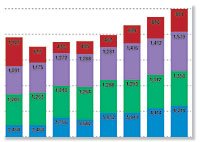profession
More minorities enrolling at med schools, particularly Hispanics
■ The AAMC finds the increase encouraging because more doctors are needed to reflect the diversity of communities.
By Carolyne Krupa — Posted Oct. 25, 2010
- WITH THIS STORY:
- » More minorities in med school
- » Related content
American medical schools are seeing gains in minority enrollment, with the most significant growth occurring among blacks, Hispanics and Native Americans.
Overall first-year medical school enrollment at allopathic medical schools for fall 2010 rose to 18,665 students, a 1.5% increase over 2009, according to data from the Assn. of American Medical Colleges. This continues a trend of annual increases that have hovered around 2% in the last six years with the opening of new medical schools and expansion of existing schools.
Applicants to allopathic medical schools increased only slightly, from 42,269 in 2009 to 42,742 in 2010.
At the nation's 26 osteopathic medical schools, first-year enrollment rose to more than 5,500, up 6.5% from 2009. The schools are playing a key role in helping to fill the country's growing health care needs, Stephen C. Shannon, DO, MPH, president and chief executive officer of the American Assn. of Colleges of Osteopathic Medicine, said in a statement.
"The number of applicants to osteopathic medical schools is growing exponentially, from 6,814 in 2003 to more than 13,300 for the 2011 entering class," he said.
Minority enrollment rises
Looking at allopathic schools' minority enrollment, there are 1,539 first-year Hispanic students this year, up 9.1% over 2009. The number of black medical students rose to 1,350, a 2.9% increase from 2009. The number of Native Americans or Alaskan Natives rose to 191, a 24.8% jump from last year.
The increases are encouraging at a time when more minority physicians are needed to treat an increasingly diverse population, said Darrell Kirch, MD, AAMC president and chief executive officer. "You don't improve the health of communities without having a work force that reflects the diversity of those communities," he said.
Medical schools nationwide are targeting minorities, often as early as grade school. Many schools offer programs designed to foster an interest in science and medicine among children and teenagers. Some programs guarantee medical school admission to high school and college undergraduates who meet program requirements, such as maintaining a certain grade point average and participating in educational summer programs.
Almost 80% of applicants come from the top 40% income levels, a fact that has held steady for a decade, said Gwen Garrison, PhD, AAMC's director of student and applicant studies.
"This is something we've been monitoring very closely for some time and remains a definite concern here at the AAMC," Henry Sondheimer, MD, senior director of student affairs and student programs, said in a national teleconference Oct. 13. "The socioeconomic profile of the applicant pool and the matriculant pool is really not the same as the population as a whole."
The cost of medical school is often cited as a contributing factor, as well as education systems that fail to prepare students for college and the rigors of medical school. Several medical schools are revising application requirements and have programs to attract lower-income students, Dr. Sondheimer said.
The key issue is with the K-12 system, Dr. Kirch said. "It's really a question of what opportunities people have through high school and to go to college that will shape the pool that is available for professional schools like medicine," he said.
Medical school opens
The number of medical schools continues to grow. One new medical school opened this fall, and two others were accredited through the Liaison Committee on Medical Education. School expansions nationwide will add an estimated 7,000 graduates annually during the next decade.
The newest school, Virginia Tech Carilion School of Medicine and Research Institute in Roanoke, is a public-private partnership between Virginia Tech and Carilion Clinic, a health care organization with 600 physicians in group practice and eight hospitals.
The school started with its first class of 42 students in August with an emphasis on research and interdisciplinary training, said Cynda Johnson, MD, the medical school's president and dean. "We are positioning ourselves for the future," she said.
The future will see widespread work force shortages, according to the AAMC. Expansion of coverage under health system reform law and increased demand for care from baby boomers are expected to drive nationwide physician shortages to 62,900 doctors in five years and 91,500 by 2020, AAMC data show.
While medical schools are growing, residency programs have not kept pace, Dr. Kirch said. The AAMC is urging federal officials to lift limits on Medicare -- the largest source of funding for residency positions, which have been capped at 100,000 slots since 1997. A 15% increase in residency slots would allow for training of an additional 4,000 physicians annually.













